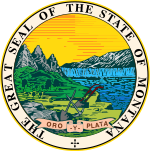| |||||||||||||||||||||
| |||||||||||||||||||||
 County results Murray: 40-50% 50–60% 60–70% 70–80% Monaghan: 40–50% No data Tie | |||||||||||||||||||||
| |||||||||||||||||||||
| Elections in Montana |
|---|
 |
The 1930 United States Senate election in Montana took place on November 3, 1936. Incumbent United States Senator James E. Murray, who was first elected to the Senate in a special election in 1934, ran for re-election. He narrowly emerged from a competitive and close Democratic primary, wherein he was challenged by United States Congressman Joseph P. Monaghan, who represented Montana's 1st congressional district. In the general election, Murray was opposed by Thomas O. Larson, a State Senator and the Republican nominee, and Monaghan, who, after losing the primary, ran as an independent candidate. Murray ended up winning a second term, and his first full term, in a landslide, defeating both of his opponents by a comfortable margin.


